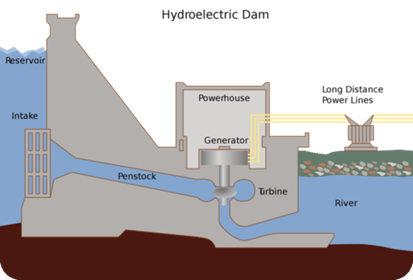GENERATOR
Generator
The sprawling machines in this plant aren’t factory machines, but they do produce something. They are electric generators in a hydroelectric power plant, and they produce electricity.
Generating Electricity
An electric generator is a device that changes kinetic energy to electrical energy through electromagnetic induction. Electromagnetic induction is the process of generating electric current with a magnetic field. It occurs when a magnetic field and an electric conductor, such as a coil of wire, move relative to one another.
A simple diagram of an electric generator is shown in the Figure below. In any electric generator, some form of energy is applied to turn a shaft. The turning shaft causes a coil of wire to rotate between the opposite poles of a magnet. Because the coil is rotating in a magnetic field, electric current is generated in the wire.

[Figure 2]
Q: What might happen to the current produced by an electric generator if the poles of the magnet kept reversing?
A: The direction of the current would also keep reversing. In other words, the electric generator would generate alternating current.
From Kinetic to Electrical Energy
Generators may be set up to produce either direct or alternating current. Generators in cars and most power plants produce alternating current. Regardless of the type of current, all generators change kinetic energy to electrical energy.
· A car generator produces electricity with some of the kinetic energy of the turning crankshaft. The electricity is used to run the car’s lights, power windows, radio, and other electric devices. Some of the electricity is stored in the car’s battery to provide electrical energy when the car isn’t running.
· A power plant generator produces electricity with the kinetic energy of a turning turbine. The energy to turn the turbine may come from burning fuel, falling water, or some other energy source. You can see how falling water is used to generate electricity in a hydroelectric power plant in the Figure below.

[Figure 3]
Q: The water flowing through the dam and over the turbine has kinetic energy because it is moving. Where does the water get the energy to move?
A: When the water is in the reservoir, it has potential energy because of gravity. Potential energy is stored in the water because of its position behind the dam. When the water flows into the intake pipe, gravity pulls it downhill to the power plant.
Watch the video below to learn more about hydropower and other ways to generate electricity:
Summary
· An electric generator is a device that produces electricity through electromagnetic induction. Electromagnetic induction is the process of generating electric current with a magnetic field.
· Generators may produce either alternating or direct current, but they all change kinetic energy to electrical energy.
Review
1. Identify the parts of an electric generator and what they do.
2. Explain how an electric generator in a hydroelectric power plant changes kinetic energy to electrical energy.
3. An electric motor is a device that changes electrical energy to kinetic energy. How is an electric generator like an electric motor in reverse?